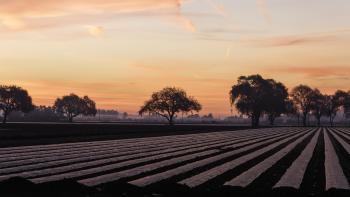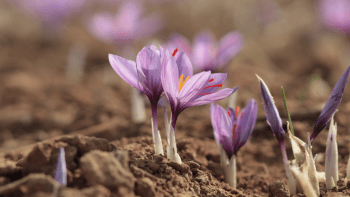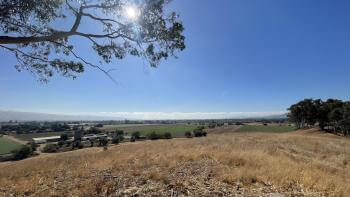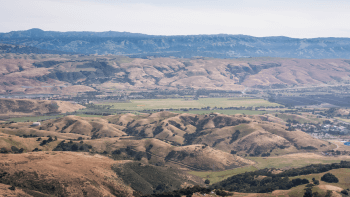Unsung Heifers of the Open Space Authority
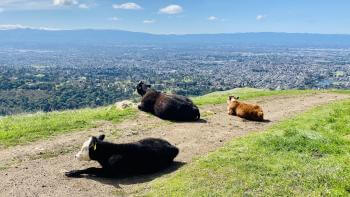
Ever visit an Open Space Authority preserve to get moo-ving and spot a few cows? While they may make it feel like you're traversing through the set of an old Western film, those cows are not paid actors! The Authority uses cattle grazing as an udder-ly integral conservation and management strategy.
Cattle grazing is one of the Authority’s tools for conservation. When done properly, it’s a minimally invasive and an effective conservation technique. For years, the Open Space Authority has used this practice on eight thousand acres of the land the agency manages.
Why cattle grazing?
There are a variety of benefits and goals that this practice aims to achieve. “We use it to manage our vegetation--specifically grasslands, reduce invasive species in composition and in numbers, reduce fire fuel load and increase native plant diversity,” says Aaron Hébert, Natural Resources Manager. Managing the quantity of the growth of invasive species makes more space available for native plants to grow and grazing of excess dry plant matter means less fuel for fires to burn.
And these benefits are measurable. The Authority is working with a GIS consultant to support the agency’s fire fuel management program, and the GIS modeling shows that its use of cattle grazing substantially lowered the fire risk on grasslands when compared to nearby non-grazed grasslands.
In places like Máyyan 'Ooyákma - Coyote Ridge Open Space Preserve, pollution like smog settles on the land as nitrogen, which in turn fertilizes grass growth, creating taller and bigger plants than would be here naturally. Native species, like the burrowing owl, depend on short grass in order to thrive because they are too short to peer out from their burrows and see over larger plants. That’s where cattle come in to help keep the grass short.
Cattle are an especially useful tool in serpentine habitats, which are special ecosystems defined by California's official state rock, serpentine. This rock produces soil low in nutrients and all sorts of rare native plants are found in there. At Máyyan 'Ooyákma - Coyote Ridge Open Space Preserve, the threatened Bay checkerspot butterfly depends on the high abundance of native plants in this serpentine landscape. Their larvae grow on some very small plants that, if not for cattle grazing, would get overshadowed by bigger invasive species. So, there’s a complex cycle of pollution, nitrogen fertilization, grass growth, and native species that depend on shorter grasslands. Cattle are the most effective tool to manage these ecosystems over thousands of acres and ranchers are a huge part of the team of people who do it.
Additionally, old ponds built as water supplies for cattle now support rare species like California red-legged frog and California tiger salamanders. Without that history of ranchers managing the land, many of these species would not be here today.
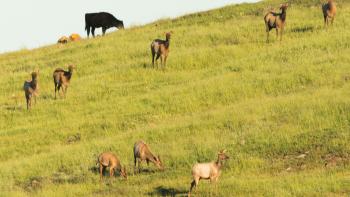
When is cattle grazing used?
When determining which properties need to be grazed, there are short-term and long-term considerations. For the long-term determination, every property has a grazing plan that discusses our management goals which includes how much residual dry matter, or old plant material left on the ground, is on the landscape. If there is a significant amount of dry matter, which is also fuel for fires, then it's time to bring in a herd.
Short-term considerations are much more site- and weather-specific, and these change each year, based on the composition of invasive species throughout a landscape, the amount of rainfall an area experienced and the presence, maintenance and/or construction of trails.
Like most management strategies, cattle grazing has no shortage of challenges. For one, weather patterns are always a consideration. During years of drought, there is less for cattle to eat and often ranchers must reduce their grazing herd and adjust their profit margins.
What are some of the challenges of cattle grazing?
Cattle grazing poses logistical challenges, as well. The number of cows distributed into a region is determined by a formula – it measures the specific landcover type and the landcover’s productivity estimate, which then determines the number of animals needed to achieve respective residual dry matter targets. Once that is determined, ranchers – often on horseback -- will distribute the cows to the landscape. Water must always be readily available for cattle on any given property, and infrastructure like fencing around a landscape must be consistently upgraded or maintained for the cattle’s safety.
Regardless of the challenges, cattle grazing remains an effective and low impact landscape level conservation and land management tool. To learn more about the Authority’s conservation work, click here.
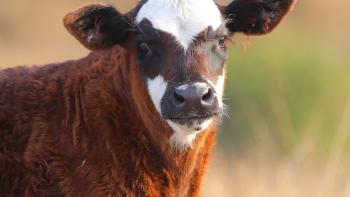
Quick tips for sharing the trail with cows:
- Always be aware of your surroundings and keep a respectful distance from cattle. If cattle are blocking the trail, approach them slowly, speak normally and allow them to move off the trail. If they don’t move away on their own, give them a lot of space when walking around them.
- Avoid any behavior that may provoke livestock. This includes "moo-ing," trying to touch them or attempting to take up-close selfies.
- If you see a stray calf, stay away from it. The mother will return, and you do not want to get between a mother cow and her calf. Often mothers will leave their calf to get water, and moving or interfering may cause the mother to abandon their calf.
- Every now and then you may see a cow giving birth. If this happens, keep a respectful distance so as not to startle or disturb this process.
- Close any gates you pass through on the trail.
